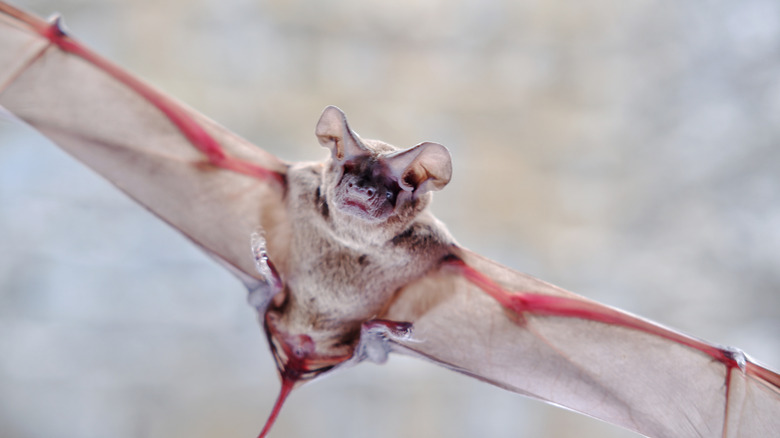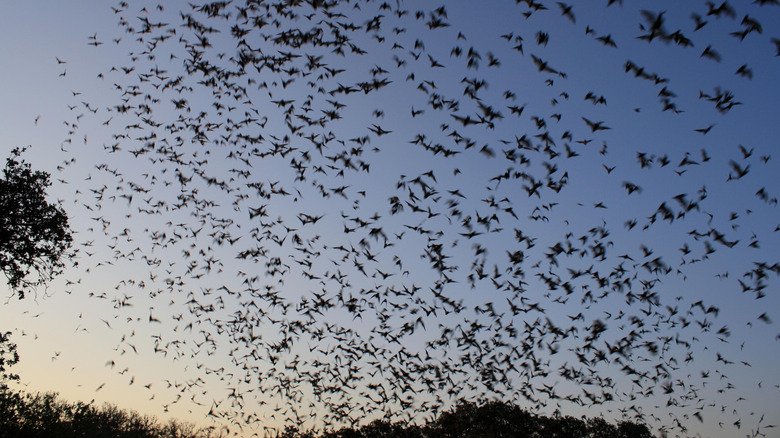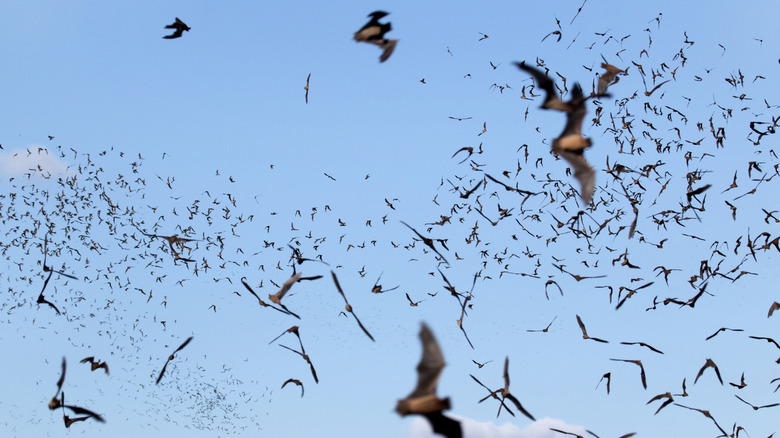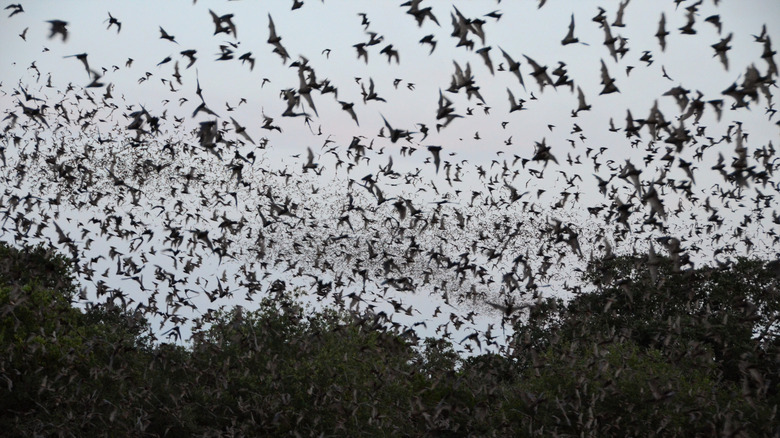The Texas Cave That Houses The Largest Bat Colony In The World
There are more than 1,400 species of bats worldwide, and 47 of them reside in the United States. Some states are absolutely packed with these flying mammals, while others have relatively few. For instance, 14 bat species are found in North Georgia, while Oklahoma has 24. Arizona is close to the top of the list with 28 species of bat, but the state with by far the most is Texas, with 32.
That's not a bad thing, either. The animals play important roles in ecosystems, to the extent that we can't really afford to lose bats at all. Not only do they help with pollinating plants such as agave, bananas, and mangoes, bats also help disperse seeds and regenerate natural environments as a result. They're also great for pest control thanks to their predilection for insects, which in turn means less pesticides are required.
With that in mind, Texas should be pretty pleased to host so many of the creatures and should be especially proud to host what is the largest colony of bats in the world.
Texas' giant bat population
Texas is a very biodiverse state. It hosts tens of thousands of native animal and plant species, which reside in more than 800 habitat types across the four natural regions of Texas. The second-largest state in the United States is home to such creatures as the Texas horned lizard, the western diamondback rattlesnake, and of course, the Texas longhorn. But when you think of the Lone Star State, you probably don't necessarily think of bats. Interestingly enough, however, Texas is actually home to the largest colony of bats in the world, with the Bracken Cave Preserve containing more than 15 million Mexican free-tailed bats during the summer. That also makes it one of the largest concentrations of mammals in the world.
Sitting just north of San Antonio, Bracken Cave provides sanctuary for female Mexican free-tailed bats returning from Central and South America after the winter months. March and April see millions of females settle in the preserve, before giving birth to single pups in June, thereby instantly doubling the bat population of Bracken Cave. The site has become a popular destination for those looking to watch the millions of bats emerge from the cave at dusk in an impressive tornado that signals the beginning of their nightly insect hunt.
Mexican free-tailed bats are small but fast
Mexican free-tailed bats (Tadarida brasiliensis) are one of the smaller bat species, usually measuring around 4 inches long with a wingspan of roughly 12 inches and averaging around 12 grams in weight. Their name derives from the fact that the bats' tails extend beyond the uropatagium, the membrane between the tail and the animals' hind legs. These creatures are also some of the best fliers of all bat species, and can reach speeds of more than 60 miles per hour. Their diet includes insects such as beetles, flies, and ants, but they mostly feed on moths and are a particularly great form of pest control for cotton bollworm and army cutworm moths.
Sometimes referred to as Brazilian free-tailed bats, Mexican free-tailed bats are found across Central and South America, but are also present in multiple states across the U.S., including Oregon, Utah, Nebraska, Arkansas, Alabama, South Carolina, and, of course, Texas. Despite the fact that bat colonies typically consist of between hundreds of thousands and millions of bats, none of the other states can claim to have as many Mexican free-tailed bats as Texas' Bracken Cave Preserve.
Bracken Cave Preserve is a actually a dangerous place for young bats
Texas' Bracken Cave Preserve is truly remarkable not only for the sheer amount of bats that reside there during the spring and summer months, but because of the way in which the female birthing process plays out. After the females produce their single pups, they leave them on the cave walls in clusters called creches, which can see as many as 400 pups packed into a single square foot. Being so closely packed together allows the baby bats to stay warm despite their lack of hair, while the mothers can leave the cave to hunt for food. Even more incredible is that when the mother bats return to the cave after hunting, they are able to single out their own pups from the millions of others on the cave walls.
Once the young bats have made it to their fourth or fifth week, they are typically ready to start learning to fly. But while the largest bat colony in the world might seem like the perfect environment for these young pups, Bracken Cave is a surprisingly treacherous environment. When the young bats begin to fly, they test their echolocation for the first time while flying in complete darkness. During this process, they can easily slam into other bats or even hit the cave walls, which are two scenarios that can frequently result in serious injury or death. Even if they do survive such impacts, the young bats face yet another life-threatening aspect of the caves. As Bat Conservation International points out, the floor is "teeming with millions of carnivorous dermestid beetles that can reduce a young bat to a cleaned skeleton within a few minutes." It's perhaps unsurprising, then, that at least half of the newborn bats don't survive their first year.
Those that do, however, eventually contribute to the magnificent sight of millions of bats pouring out of Bracken Cave to hunt — a sight that gives Texas yet another truly unique natural feature.



